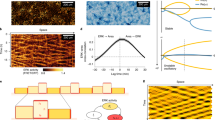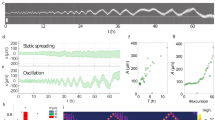Abstract
Cell motility is a process deriving from the synchronized dynamics of the cytoskeleton. In several important physiological processes—notably, cancer metastasis—the randomly moving cells can acquire a directional motility phenotype and bias their motions in response to environmental cues. Despite intense research, however, the current understanding of directional cell migration is incomplete and there is a growing need to develop systems that would enable the study and control of this process. This article demonstrates that random motions of motile cells can be rectified by asymmetric (‘ratchet’) microgeometries. Interactions between the cells and the imposed geometrical cues guide cell polarization and give rise to directional motility. Depending on the ratchet design, cells of different types can move either in the same or in opposite directions on the same imposed pattern. In the latter case, it is possible to partially sort mixed cell populations into different collecting reservoirs.
This is a preview of subscription content, access via your institution
Access options
Subscribe to this journal
Receive 12 print issues and online access
$209.00 per year
only $17.42 per issue
Buy this article
- Purchase on Springer Link
- Instant access to full article PDF
Prices may be subject to local taxes which are calculated during checkout





Similar content being viewed by others
References
Lee, S. H. & Grier, D. G. One-dimensional optical thermal ratchets. J. Phys. Condens. Matter 17, S3685–S3695 (2005).
Lee, C. S., Janko, B., Derenyi, I. & Barabasi, A. L. Reducing vortex density in superconductors using the ‘ratchet effect’. Nature 400, 337–340 (1999).
Lorke, A. et al. Far-infrared and transport properties of antidot arrays with broken symmetry. Physica B 251, 312–316 (1998).
Rousselet, J., Salome, L., Ajdari, A. & Prost, J. Directional motion of Brownian particles induced by a periodic asymmetric potential. Nature 370, 446–448 (1994).
Engel, A., Muller, H. W., Reimann, P. & Jung, A. Ferrofluids as thermal ratchets. Phys. Rev. Lett. 91, 060602 (2003).
Linke, H. et al. Experimental tunneling ratchets. Science 286, 2314–2317 (1999).
van Oudenaarden, A. & Boxer, S. G. Brownian ratchets: Molecular separations in lipid bilayers supported on patterned arrays. Science 285, 1046–1048 (1999).
Villegas, J. E. et al. A superconducting reversible rectifier that controls the motion of magnetic flux quanta. Science 302, 1188–1191 (2003).
Hiratsuka, Y., Tada, T., Oiwa, K., Kanayama, T. & Uyeda, T. Q. P. Controlling the direction of kinesin-driven microtubule movements along microlithographic tracks. Biophys. J. 81, 1555–1561 (2001).
Matthias, S. & Muller, F. Asymmetric pores in a silicon membrane acting as massively parallel Brownian ratchets. Nature 424, 53–57 (2003).
Reimann, P. Brownian motors: Noisy transport far from equilibrium. Phys. Rep.-Rev. Sec. Phys. Lett. 361, 57–265 (2002).
Astumian, R. D. & Hanggi, P. Brownian motors. Phys. Today 55, 33–39 (2002).
Feynman, R. P., Leighton, R. B. & Sands, M. L. The Feynman Lectures on Physics Vol. 1 (Pearson/Addison-Wesley, 2006).
Peskin, C. S., Odell, G. M. & Oster, G. F. Cellular motions and thermal fluctuations—the Brownian ratchet. Biophys. J. 65, 316–324 (1993).
Silva, C. C. D., de Vondel, J. V., Morelle, M. & Moshchalkov, V. V. Controlled multiple reversals of a ratchet effect. Nature 440, 651–654 (2006).
Kelly, T. R., De Silva, H. & Silva, R. A. Unidirectional rotary motion in a molecular system. Nature 401, 150–152 (1999).
Simon, S. M., Peskin, C. S. & Oster, G. F. What drives the translocation of proteins. Proc. Natl Acad. Sci. USA 89, 3770–3774 (1992).
Alt, W. Biased random-walk models for chemotaxis and related diffusion approximations. J. Math. Biol. 9, 147–177 (1980).
Dunn, G. A. & Brown, A. F. A unified approach to analyzing cell motility. J. Cell Sci. Suppl 8, 81–102 (1987).
Theriot, J. A. & Mitchison, T. J. Actin microfilament dynamics in locomoting cells. Nature 352, 126–131 (1991).
Ponti, A., Machacek, M., Gupton, S. L., Waterman-Storer, C. M. & Danuser, G. Two distinct actin networks drive the protrusion of migrating cells. Science 305, 1782–1786 (2004).
Thery, M. et al. Anisotropy of cell adhesive microenvironment governs cell internal organization and orientation of polarity. Proc. Natl Acad. Sci. USA 103, 19771–19776 (2006).
Thery, M., Pepin, A., Dressaire, E., Chen, Y. & Bornens, M. Cell distribution of stress fibres in response to the geometry of the adhesive environment. Cell Motil. Cytoskeleton 63, 341–355 (2006).
Jiang, X. Y. et al. A general method for patterning gradients of biomolecules on surfaces using microfluidic networks. Anal. Chem. 77, 2338–2347 (2005).
Dertinger, S. K. W., Jiang, X. Y., Li, Z. Y., Murthy, V. N. & Whitesides, G. M. Gradients of substrate-bound laminin orient axonal specification of neurons. Proc. Natl Acad. Sci. USA 99, 12542–12547 (2002).
Brandley, B. K. & Schnaar, R. L. Tumor-cell haptotaxis on covalently immobilized linear and exponential gradients of a cell-adhesion peptide. Dev. Biol. 135, 74–86 (1989).
Smith, J. T. et al. Measurement of cell migration on surface-bound fibronectin gradients. Langmuir 20, 8279–8286 (2004).
Plummer, S. T., Wang, Q., Bohn, P. W., Stockton, R. & Schwartz, M. A. Electrochemically derived gradients of the extracellular matrix protein fibronectin on gold. Langmuir 19, 7528–7536 (2003).
Campbell, C. J., Smoukov, S. K., Bishop, K. J. M., Baker, E. & Grzybowski, B. A. Direct printing of 3d and curvilinear micrometer-sized architectures into solid substrates with sub-micrometer resolution. Adv. Mater. 18, 2004–2008 (2006).
Kandere-Grzybowska, K., Campbell, C., Komarova, Y., Grzybowski, B. A. & Borisy, G. G. Molecular dynamics imaging in micropatterned living cells. Nature Meth. 2, 739–741 (2005).
Maroudas, N. G. Polymer exclusion, cell adhesion and membrane-fusion. Nature 254, 695–696 (1975).
Prime, K. L. & Whitesides, G. M. Self-assembled organic monolayers—model systems for studying adsorption of proteins at surfaces. Science 252, 1164–1167 (1991).
Singhvi, R. et al. Engineering cell-shape and function. Science 264, 696–698 (1994).
Kandere-Grzybowska, K. et al. Cell motility on micropatterned treadmills and tracks. Soft Matter 3, 672–679 (2007).
Jiang, X. Y., Bruzewicz, D. A., Wong, A. P., Piel, M. & Whitesides, G. M. Directing cell migration with asymmetric micropatterns. Proc. Natl Acad. Sci. USA 102, 975–978 (2005).
Groisman, A. & Quake, S. R. A microfluidic rectifier: Anisotropic flow resistance at low reynolds numbers. Phys. Rev. Lett. 92, 094501 (2004).
Grazi, E., Cintio, O. & Trombetta, G. On the mechanics of the actin filament: The linear relationship between stiffness and yield strength allows estimation of the yield strength of thin filament in vivo. J. Muscle Res. Cell Motil. 25, 103–105 (2004).
Brown, C. M. et al. Probing the integrin-actin linkage using high-resolution protein velocity mapping. J. Cell Sci. 119, 5204–5214 (2006).
Thatcher, A. R. Studies in the history of probability and statistics vi. A note on the early solutions of the problem of the duration of play. Biometrika 44, 515–518 (1957).
Kumar, A., Galaev, I. Y. & Mattiasson, B. (eds) Cell Separation: Fundamentals, Analytical and Preparative Methods Vol. 106 (Springer, 2007).
Steinberg, M. S. & Takeichi, M. Experimental specification of cell sorting, tissue spreading, and specific spatial patterning by quantitative differences in cadherin expression. Proc. Natl Acad. Sci. USA 91, 206–209 (1994).
Xu, Q. L., Mellitzer, G., Robinson, V. & Wilkinson, D. G. In vivo cell sorting in complementary segmental domains mediated by eph receptors and ephrins. Nature 399, 267–271 (1999).
Keren, D. F., McCoy, J. P. & Carey, J. L. Flow Cytometry in Clinical Diagnosis 3rd edn (American Society Clinical Pathology, 2001).
Jennings, C. D. & Foon, K. A. Recent advances in flow cytometry: Application to the diagnosis of hematologic malignancy. Blood 90, 2863–2892 (1997).
Steinberg, M. S. Reconstruction of tissues by dissociated cells. Science 141, 401–408 (1963).
Townes, P. L. & Holtfreter, J. Directed movements and selective adhesion of embryonic amphibian cells. J. Exp. Zool. 128, 53–120 (1955).
Discher, D. E., Janmey, P. & Wang, Y. L. Tissue cells feel and respond to the stiffness of their substrate. Science 310, 1139–1143 (2005).
Wyckoff, J. B., Segall, J. E. & Condeelis, J. S. The collection of the motile population of cells from a living tumor. Cancer Res. 60, 5401–5404 (2000).
Gail, M. H. & Boone, C. W. Locomotion of mouse fibroblasts in tissue culture. Biophys. J. 10, 980–993 (1970).
Acknowledgements
This work was supported by the NCI Northwestern CCNE (NIH 1U54CA119341-01), the Pew Scholars Program in the Biomedical Sciences (to B.A.G.) and the Sloan Fellowship (to B.A.G.). G.M. was supported by a Gates Fellowship. C.J.C. was supported by a Northwestern University Presidential Fellowship. K.J.M.B. was supported by an NSF Graduate Research Fellowship. K.K.-G. was supported by a Fellowship from a Department of Defense Breast Cancer Research Program (W81XW4-05-1-0312).
Author information
Authors and Affiliations
Contributions
G.M. C.J.C, Y.A.K. and K.K.-G. carried out most experiments and data analysis; Y.A.K., K.K.-G., O.C. and S.H. carried out high-resolution in-cell imaging; K.J.M.B. and S.S. developed the theoretical model; K.K.-G. and B.A.G. conceived the experiments and wrote the paper.
Corresponding authors
Supplementary information
Supplementary Information
Supplementary Information (PDF 721 kb)
Supplementary Information
Supplementary Movie 1 (MOV 226 kb)
Supplementary Information
Supplementary Movie 2 (MOV 573 kb)
Supplementary Information
Supplementary Movie 3 (MOV 409 kb)
Supplementary Information
Supplementary Movie 4 (MOV 347 kb)
Rights and permissions
About this article
Cite this article
Mahmud, G., Campbell, C., Bishop, K. et al. Directing cell motions on micropatterned ratchets. Nature Phys 5, 606–612 (2009). https://doi.org/10.1038/nphys1306
Received:
Accepted:
Published:
Issue Date:
DOI: https://doi.org/10.1038/nphys1306
This article is cited by
-
Biointerfaces with ultrathin patterns for directional control of cell migration
Journal of Nanobiotechnology (2024)
-
Bladder cancer: therapeutic challenges and role of 3D cell culture systems in the screening of novel cancer therapeutics
Cancer Cell International (2023)
-
Mussel-inspired interfacial ultrathin films for cellular adhesion on the wrinkled surfaces of hydrophobic fluids
Polymer Journal (2023)
-
Acoustic and Magnetic Stimuli-Based Three-Dimensional Cell Culture Platform for Tissue Engineering
Tissue Engineering and Regenerative Medicine (2023)
-
Triangular-prism Microstructure Engineered on the Fibrous Scaffold Using Electro-centrifugal Spinning Technique for Tissue Engineering
Fibers and Polymers (2022)



